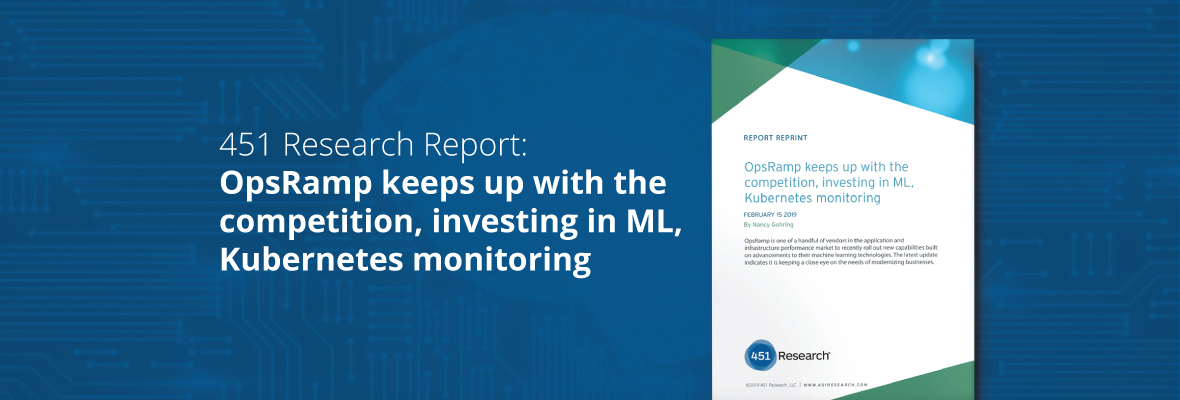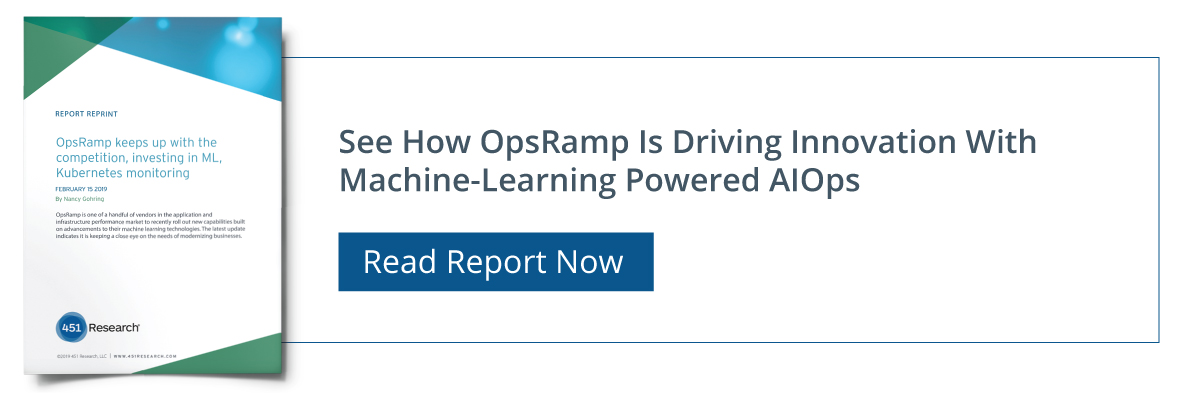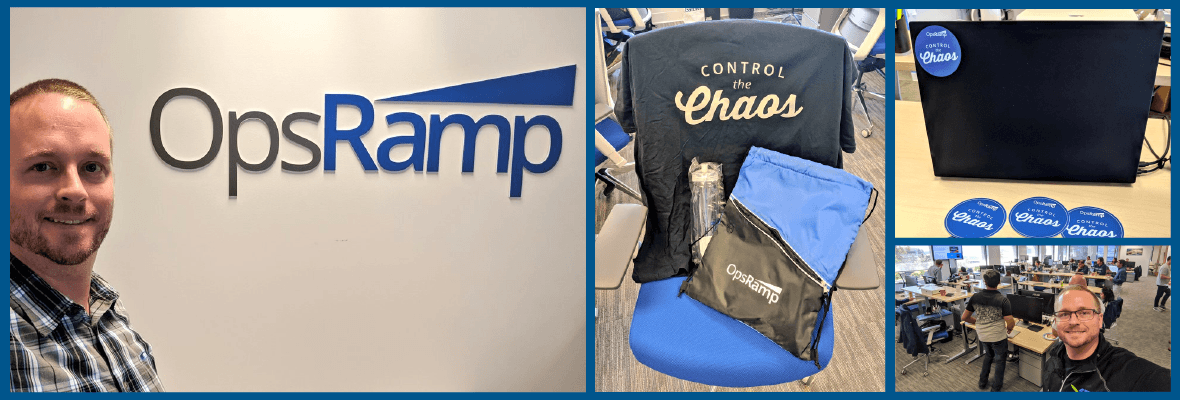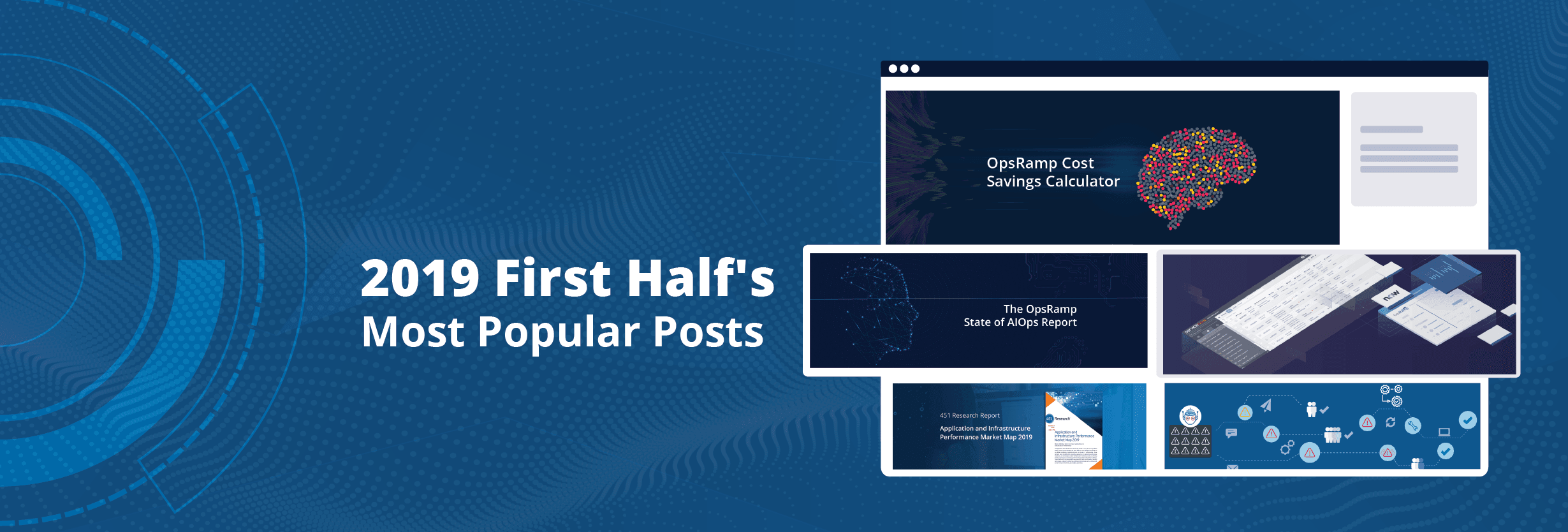OpsRamp was recently featured in the 451 Research Impact report, OpsRamp Keeps Up With The Competition, Investing in ML, Kubernetes Monitoring. This report, written by Nancy Gohring, 451 Research’s senior analyst for Application and Infrastructure Performance, demonstrates how OpsRamp is one of the few vendors that has organically built and delivered a transformational SaaS solution for modern IT operations, DevOps, and Site Reliability Engineering teams.
OpsRamp’s platform “offers a long list of capabilities that address the needs of enterprises that are modernizing their IT environments,” according to the report. It also calls out OpsRamp for delivering an innovative digital operations platform: “OpsRamp was forward thinking from the start, offering a SaaS deployment model and investing in machine learning-driven capabilities early on, allowing it to keep pace with other forward-looking vendors.” It also highlights three benefits of using OpsRamp for real-time incident management, unified hybrid management, and contextual visibility:
#1 - Manage the Entire Lifecycle of IT Outages, with Machine Learning Analytics.

Given that it takes more than five hours to recover from an IT outage, OpsRamp’s service-centric AIOps platform focuses on reducing the human effort spent in detecting, repairing, and restoring critical IT services. Our January 2019 release introduced machine learning-powered innovations for incident diagnosis, escalation, and resolution so that DevOps teams can manage IT service disruptions in a single platform without frequent context switching:
-
Auto-Incident Creation And Assignment. The 451 report describes our machine learning-based auto-incident feature as the ability to “automatically route incidents to responders based on historical patterns.” Instead of having IT teams manually create or route incidents, OpsRamp’s escalation policies can learn and automatically tag incident priority and dispatch tickets to the right assignee groups in an ITSM tool like ServiceNow.
-
Augmented Training For Alert Inferencing. We’ve made it easy for users to train and bootstrap their own AIOps solution so that the OpsQ event management engine can more accurately discern specific patterns in a customer’s IT environment. The report comments on the opening up of our AIOps engine: “We like that OpsRamp is planning to offer some transparency into its machine learning engine...New customers can also add training data in order to realize the benefits more quickly of using OpsRamp.”
-
Frequency-Driven Alert Escalation. OpsRamp now has the ability to sift out repetitive, transient alerts that come and go from those alert flaps that continue to recur and could point to a serious issue. 451 Research explains how frequency-based alert escalation helps extract the signal from the noise: “Those capabilities build on existing analytics that OpsRamp already offered, including to automatically reduce alert volumes by eliminating alerts that the system has learned aren't meaningful because, for instance, an anomaly happens every week at the same time and doesn't require a response.”
#2 - Platform Thinking for Modern IT Operations with a Multitenant SaaS Solution.

OpsRamp’s vision is to help enterprise IT teams shift from siloed thinking to proactive service delivery with a comprehensive platform for infrastructure monitoring, service-centric AIOps, and alert escalation management. OpsRamp can analyze, aggregate, and extract relevant insights through our multitenant SaaS platform and deliver new machine learning functionality across our customer base for efficient and effective IT operations:
- Data Is The New Oil. OpsRamp’s SaaS platform manages a diverse stack of hybrid workloads for holistic IT operations management in the form of metrics, alerts, and tickets across its customer base. Our SaaS platform gives us a natural advantage when it comes to pattern recognition and detection: “OpsRamp also continues to analyze data it collects across all its customers to learn patterns that can inform its algorithms.”
#3 - Impact Visibility and Service Context Matters More than Ever, in a Cloud Native World.
 What is the basis for action when a sysadmin receives two similar alerts at the same time? Unless the IT admin can analyze and prioritize an issue based on impact, there is no way to decide on the next steps. OpsRamp offers a clear line of sight for business service visibility by displaying dependency information for IT services, applications, and underlying hybrid infrastructure:
What is the basis for action when a sysadmin receives two similar alerts at the same time? Unless the IT admin can analyze and prioritize an issue based on impact, there is no way to decide on the next steps. OpsRamp offers a clear line of sight for business service visibility by displaying dependency information for IT services, applications, and underlying hybrid infrastructure:-
Service Context. OpsRamp’s new service context capabilities come in the form of application topology (end-to-end dependency mapping for forty popular open-source applications), hypervisor topology (discover virtual machines and hypervisor servers in VMware vSphere and KVM environments), and a refreshed service maps UI (understand and apply impact information for taking action). 451 Research explains why service context is so critical in an increasingly hybrid world: “The ability to understand the relationship across the many elements that make up a modern application is more important than ever, given the growing complexity of most application environments.”
-
Cloud Native Management. OpsRamp can now discover and monitor container infrastructure that supports agile and dynamic microservices environments. We’ve joined the Cloud Native Computing Foundation as a silver member to help enterprise IT teams manage and optimize cloud native workloads. The report explains how we are extending support for the popular Kubernetes container orchestration framework: “OpsRamp continues to build out the technologies that it can monitor, this time delivering Kubernetes monitoring in both on-premises environments as well as for workloads running in Azure Kubernetes Services, Google Kubernetes Engine and Amazon Elastic Container Service for Kubernetes.”
Next steps:
- Learn more about OpsRamp and what makes us different.
- Find out what's new in the OpsRamp platform.
- Schedule a custom demo with an OpsRamp solution expert.






